There have been a lot of debates surrounding 5th edition D&D, but few have felt more confusing than the “Who, what, when, and why?” of passive perception. Even over 5 years after the release of fifth edition, this is a topic that still causes debate and confusion.
This is incredibly unfortunate, since passive perception, like other passive skill checks in 5E Dungeons and Dragons, is actually a pretty cool mechanic that can significantly reduce dice rolls for repetitive tasks or allow the DM to determine which party members notice something hidden with an “automatic success rate”.
For DMs looking to speed up games, organically parcel out information to players, and run sessions more smoothly, passive perception is the godsend you didn’t know you needed.
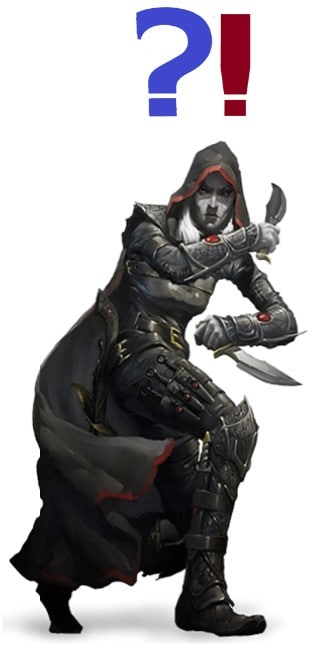
What is Passive Perception?
Passive perception is an optional game mechanic in D&D that represents a character’s ability to automatically notice details of their surroundings. This does not require a die roll, and its base calculation is 10 + their Wisdom modifier + their Proficiency Bonus (if proficient).
Game masters, as a DM, you’ll want to treat passive perception as the floor of what a character is going to notice. Keeping a list of your party’s passive perception scores on hand will help prevent you from tipping them off to the possibility something is amiss if there is information you intend to be secret.
For example, if you have something hidden in a room that would require a 16 to find, a character with a passive perception of 17 doesn’t need to roll. They should simply notice it. A character with a passive perception of 15? They will need to roll an active check – if you prompt them or they think to do so.
Want any evidence this is how passive perception actually works from an expert?
How about from Head Rules Master of Dungeons & Dragons Fifth Edition, Jeremy Crawford?
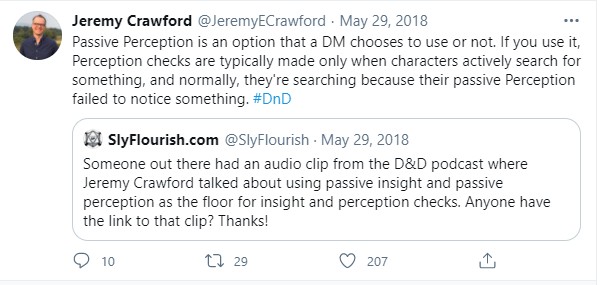
How to Calculate Passive Perception (Passive Wisdom) Checks in 5E
There’s a very direct formula for passive perception, and it can be found on page 175 of the Player’s Handbook:
10 + all modifiers that normally apply to the check.
This comes with an important point that too many players and DMs miss – you have to be PROFICIENT in the Perception skill for your proficiency bonus to be a normal modifier that applies to a 5e passive perception check.
The formula for passive perception IF THE PLAYER IS PROFICIENT IN PERCEPTION
10 + Wisdom Score Modifier + Proficiency Bonus
If the player hasn’t made their character proficient specifically in the Perception skill, then the player does NOT get to add their proficiency bonus to their passive perception score, effectively making it a passive Wisdom score.
The formula to determine passive Wisdom in 5e is:
10 + Wisdom Score Modifier
Your Wisdom modifier and proficiency bonus aren’t the only parts of these equations that can matter when calculating passive perception, however.
In situations where there are loud noises, combat is taking place, or there are distractions of some kind, a DM can choose to have those types of things affect passive perception which might mean even if a character’s passive perception would normally be high enough to notice a detail, battling a Mimic that just transformed from an inn bed could, understandably, keep them from noticing certain details while distracted.
There is a whole slew of items, feats, and other abilities that will ensure nothing escapes your keen notice, so a little preparation will keep you one step ahead of your opposition.
How to Increase Passive Perception in 5E
As a player, asking your DM whether you can look over what feels like the millionth room to try and find out whether it has a concealed nook, an enemy in the shadows, or a hidden exit can definitely wear thin – especially if your character is supposed to be good at noticing these sorts of things.
Fortunately, there are ways you can boost your D&D character’s passive perception throughout the course of a campaign, which will allow you to simply notice the majority of these secrets by entering the room.
Better still, we’re going to show you all of them right here! There are a few notes to clarify real quick before we look at the table though:
- An item, feat, or ability that gives you advantage on passive perception checks adds a +5 bonus to your score.
- Conversely, disadvantage inflicts a -5 penalty on passive perception. Remember, an instance of advantage cancels an instance of disadvantage and vice-versa.
- You can only gain a +5 bonus on a passive skill check through advantage up to one time per check.
- This means stacking a Sentinel Shield with Eyes of the Eagle is pointless. One instance of disadvantage will cancel all instances of advantage and vice-versa.
- Class features like Expertise do not stack with feats like Skill Expert – you can only double a skill proficiency once.
- Certain feats can increase your Wisdom by 1, which may or may not increase your Wisdom modifier. Unless such a feat also impacts your Perception skill and/or passive perception score, it will not be listed here.
- Your character is assumed to already be proficient in Perception skill checks.
Items, feats, class features, and other increases have been sourced from the Player’s Handbook, Dungeon Master’s Guide, Xanathar’s Guide to Everything, and Tasha’s Cauldron of Everything. Artifacts are excluded.
| Increase Method | Effect |
|---|---|
| Ability Score Increase (Wisdom) | +2 to Wisdom (caps at 20), available at specific class levels |
| Candle of Invocation | Advantage on attack rolls, saving throws, and ability checks |
| Deck of Many Things | The Star adds +2 to any ability score (caps at 24) |
| Enhance Ability spell | Owl’s Wisdom grants advantage on Wisdom checks for up to 1 hour |
| Expertise (Bard) | Double your proficiency bonus in 2 skills you are proficient with at 3rd and 10th level |
| Expertise (Rogue) | Double your proficiency bonus in 2 skills you are proficient with at 1st and 6th level |
| Eyes of the Eagle | Advantage on Wisdom (Perception) checks that rely on sight |
| Ioun Stone of Insight | +2 to Wisdom (caps at 20) |
| Ioun Stone of Mastery | +1 to your proficiency bonus |
| Prodigy feat | Gain proficiency in 1 skill, 1 tool, 1 language, and double your proficiency bonus in a skill you are proficient with |
| Observant feat | +1 to Intelligence or Wisdom (caps at 20), +5 to passive Wisdom (Perception) checks |
| Robe of Eyes | Advantage on Wisdom (Perception) checks that rely on sight, plus other abilities |
| Rod of Alertness | Advantage on Wisdom (Perception) checks and Initiative rolls, plus other abilities |
| Sentinel Shield | Advantage on Wisdom (Perception) checks |
| Skill Expert feat | +1 to an ability score of your choice (caps at 20), gain proficiency in 1 skill, and double your proficiency bonus in a skill you are proficient with |
| Stone of Good Luck | +1 to ability checks and saving throws |
| Tome of Understanding | +2 to Wisdom, increases your Wisdom cap by the same amount |
How Does Passive Perception Work Vs. Active Perception?
There really isn’t a large a difference between the two here. Active perception, more commonly referred to as a Perception ability check, is going to result in a die roll when a player is actively looking for something around them.
This could be triggered by the DM knowing a character’s passive perception isn’t high enough to see something on its own, or because the player would like to specifically scrutinize their surroundings. The intent here is that they need to take action to glean additional information.
A real world example might involve finding a specific item in a child’s messy bedroom. You know what you’re looking for, but toys, books, and clothes are strewn all over the place, so you’re going to have to actively move things around and navigate what little floor space is available to find what you’re searching for.
Passive perception doesn’t require a die roll, and is generally used to avoid a lot of redundant, repetitive checks a character is very unlikely to fail. It’s a good way to showcase their competence while also keeping the game moving at a reasonable pace.
In a dungeon full of traps or hidden passages where the party has a rogue with a passive perception over 20, wasting spotlight time on having that character roll over and over for noticing basic traps or fake falls is going to be grindy, boring, and not make sense.
Their character has trained for this type of scenario, and it’s second nature at this point in their adventuring career. They don’t need to actively focus on looking at their surroundings to pick up details, and you, as a DM, shouldn’t undercut that by trying to prey on a 10% chance of failure across multiple d20 rolls.
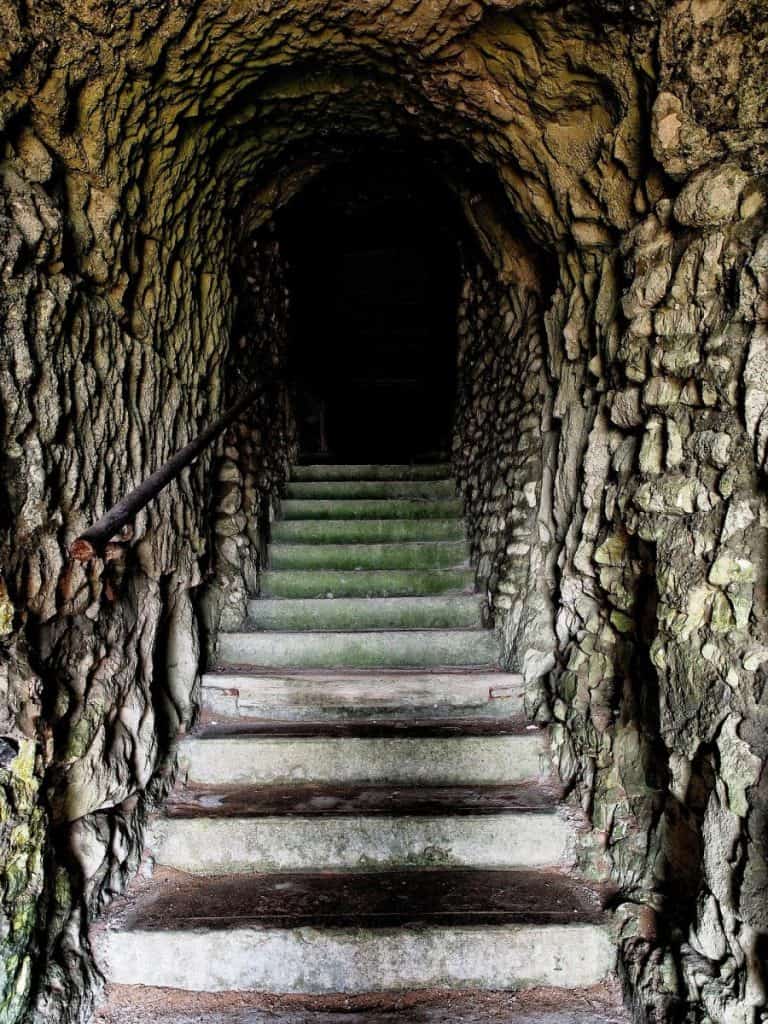
For a real world example of passive perception – think of your favorite movie or TV show. One you’ve watched countless times and put on as background noise. You can pick up details of what’s going on while remaining focused on an entirely separate task, because you have that level of familiarity with the source material.
Now that we’ve covered the differences between passive perception and active perception in D&D, it’s also important to keep in mind that there are many reasons why perception might not come into play at all.
Some spells require an intelligence check to detect or identify. The DM might decide an environment is so alien or different that a player may see something but not perceive its relevance because they don’t have the understanding, the background, or the in-campaign knowledge to make a perception check.
Some situations might also have extenuating circumstances that deserve a +5 boost or -5 penalty on either check. If a player is extra paranoid they might be more perceptive than usual, even passively. If the bard is flirting with the nearest thing with a heartbeat (as bards are known to do) you might decide their passive perception is 5 less than usual.
For a quick set of guidelines on using passive perception vs an active Perception ability check:
- If the player’s passive perception is higher than the check, just use passive perception for the win
- If a player is walking into an ambush, passive perception might determine if they know something is wrong while an active perception check might let a player see if they process information received (like an ambusher stepping on a twig that snaps) into an accurate picture
- Passive perception is used to speed up the game through checks the players should fly through without issue
- You use passive when the DM says and active when the DM calls for it or approves it at player request
It’s also worth noting that some games simply choose not to use passive perception at all. That’s a perfectly valid playstyle and will work well for certain groups.
That said, passive perception sometimes receives an unfair reputation for being game breaking, and this never has to be the case. It is usually just an underused mechanic that is a net positive for both DMs and players when used correctly during a campaign.
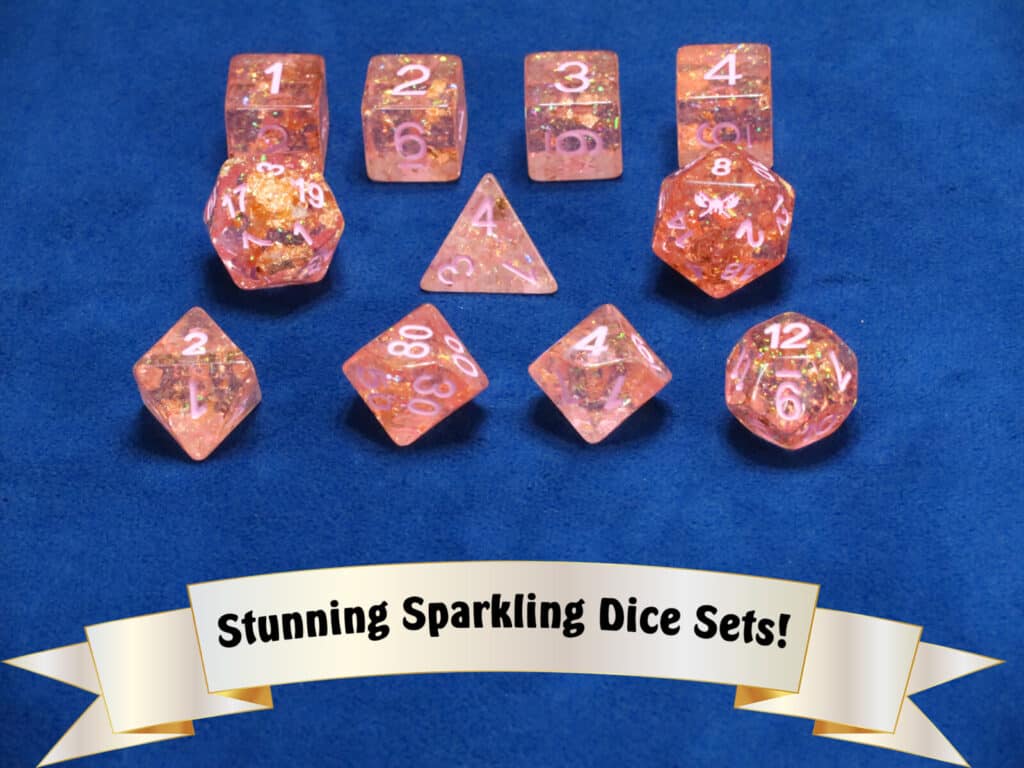
When Should You Use Passive Perception in DnD 5E?
We’ve already covered this pretty extensively, but as a DM it never hurts to have a cheat sheet.
So here’s your bullet point cheat sheet for when to use passive perception:
- To speed up the narrative of the game.
- To reward players who specialize in perceiving things.
- To determine ambushes, secrets, or what players notice without having to actively search – controlling the flow of information.
- This can also involve giving players basic information that encourages an active check OR justifies/sets the stage for an event about to happen if they don’t.
- To guide players from point A to point B by letting them perceive something they’ll then investigate further. No railroading required!
Speeding up the gameplay narrative
If your party is trying to locate a specific individual during a big celebration in town, and you have a paladin with a passive perception of 20, there’s no point in doing all those rolls.
They’re going to find their man with comparative ease, allowing you to begin the much more fun roleplay of the ensuing conversation. There’s no sense in wasting 20 minutes on what is essentially busywork.
For those who play with the Natural 1 as an automatic failure (no modifiers added) as a house rule for 5th Edition, you might choose not to use passive perception to avoid undermining that style of gameplay.
That said, it can be good to go with passive perception anyway…perhaps just saving that occasional roll for dangerous assassins posing as lookalikes or an influential twin that will wield their political clout against the party over a case of mistaken identity. You know, something that has real consequences for missing that crucial detail.
Reward your perceptive players.
One of the best things a good DM can do is give players their moments, and make them feel like their decisions are actually affecting the game.
“What’s your passive perception?”
“26.”
“Cool. In that case, your ranger hears a creature crashing through some trees 100 feet away. It sounds big, like an owlbear, and your current position is downwind of it. You’re able to direct your party toward a less traveled path through the trees that will take you upwind of where it is headed, which might allow you to get the drop on it.”
Conversations like this are a fast way to speed up the game, still keep a sense of danger, and give a nod to that player’s build and choices.
Control the flow of information
The party cleric stops by the tavern for a pint of ale after a long day at the temple, chatting with the owner before settling in at their usual table. After soaking in the usual sights and sounds of the regular patrons, the normal exuberance has been tinged by a growing din coming from the bar.
Wading through the increasingly sober and disgruntled crowd, which is being further incensed by a couple loudmouths demanding their beer, the cleric finally reaches the front to see the bartender is nowhere to be found.
The door to the owner’s quarters, visible down a hallway off to the side, is cracked open, firelight spilling into the hall. An unmistakable glint of armor is visible beyond the crack – the owner is prepared to bounce unruly patrons himself.
A scenario like the one laid out here by the DM gives the player a few options. They could use an active Perception check to see if there’s a secret trap door the bartender disappeared through behind the bar, or they could choose to get clear of the impending bar brawl the local troublemakers will start over this, and look for an opportunity to look around amidst the chaos.
They could even elect to help the owner break up the impending brawl and ask them for information afterward.
Either way, the cleric’s high passive perception has given them a good picture of what’s going on around them in the moment, and it’s up to them to determine how they want to act from here.
Guiding the story along
Passive perception can help players spot an ambush ahead of time, pick up clues that guide them towards an NPC you want them to meet, or give players a chance to see a threat or get a clue that encourages an active check.
If they choose not to do it, the DM can point back to that moment where it went sideways.
“The missing nobleman you seek is here,” says the queen of the rival military nation. “He is my guest and has not been harmed.” The war wizard spots the nobleman being escorted by the queen’s guards to her meeting area, and the words she has spoken appear to be true.
At this point, if an active perception roll isn’t initiated to see if the nobleman appears to be under duress, that’s on the party. A clear clue has been laid out to see if the nobleman is actually a traitor, and the queen seems willing to be up front with this part of the planned scheme. She is, after all, on her turf and backed up, so she could make a fight of this if pushed.

DnD 5E Passive Perception FAQ
Let’s face it: few things get more questions about mechanics in 5th edition than passive perception.
Does passive perception supersede active perception?
Most of the time yes, but this can be situational depending on how the DM chooses to interpret passive perception. In most games, information gained from passive perception almost always comes first. This is also great for repetitive tasks (checking for traps, searching for ambushes, looking over a room, etc.) and so passive perception is a great shortcut.
For an idea of how difficult a series of tasks is and whether it should just be handwaved away, here’s a quick difficulty check (DC) cheatsheet, found on page 174 of the Player’s Handbook:
| Task Difficulty | DC |
|---|---|
| Very easy | 5 |
| Easy | 10 |
| Medium | 15 |
| Hard | 20 |
| Very hard | 25 |
| Nearly impossible | 30 |
Your rogue, monk, or ranger scout will often have a passive perception of at least 20, so an easy to notice or average detail should be seen automatically. Anything with a DC over these characters’ passive perception should require an active roll.
So the passive perception comes first, and if a character’s passive perception is higher than the “success level”, the view is automatic.
Unless the situation is uncommon to the character, not a normal skill, or there’s something that puts them out of the element. Then the DM can choose to say it takes active concentration and scrutiny to make it work.
Is passive perception an optional rule?
Yes. Not only does the beginning of Fifth Edition’s Dungeon Master’s Guide emphasize that the rules are more guidelines than rules, with the only rule being that the DM always has final say, page 175 of the Player’s Handbook states: “A passive check is a special kind of ability check that doesn’t involve any dice rolls.”
While it doesn’t specifically say there it’s an optional rule, the section is written like it’s giving guiding advice for how to use an optional rule.
However, Jeremy Crawford, the lead rules designer of Dungeons & Dragons 5th Edition, has also straight out said that passive perception is an optional rule that DMs can use.
If the guy who writes the rules says it’s optional, then it’s optional.
What’s the difference between perception and investigation?
Honestly there’s a lot of overlap. The best rule of thumb is that perception uses the active senses (sound, sight, taste, etc) to notice something. Investigation is using abstract abilities like mulling over books, piecing together different stories to find holes in one, or a hard analytical focus on doing something very specific.
There are some situations where either one could be used, and which is chosen depends on possibly the preference of the DM. Examples where either skill is viable include investigating a body for clues about cause of death or looking for a hidden door or passageway.
Does passive perception include proficiency?
If your character is proficient in Perception skill checks, then you are allowed to add your proficiency bonus to your passive perception score. If not, then you cannot.
Does passive perception detect traps?
Passive perception can definitely be used to detect traps, and is useful for dealing with a large number that are easy for your character to spot. Your DM may still have you roll an active Perception check in the following scenarios:
- A particularly well hidden or deadly trap will require careful examination to be spotted and disarmed
- Your surroundings are too chaotic to pick out important details at a glance, requiring focus to tune out distractions like the sounds of battle or raging flames
- The trap in question is extremely unconventional, and outside your character’s traditional area of expertise
Can you use passive perception in combat?
While there’s nothing preventing you from doing this in the rules, it’s best to check with your DM on this one. A battlefield is a very chaotic environment, so if your character has a lot of military experience, it could easily make sense for them to be able to passively observe their surroundings because they’re used to doing so under duress.
A wizard who studied for years before being pushed into adventuring and is learning how the real world works as they go along? Probably a tougher sell.
How do you resolve stealth vs. passive perception ties?
In the event of a tie during a contested skill check, Page 174 of the Player’s Handbook states that “the situation remains the same as it was before the contest.”
So if the creature was already hidden through a previous Stealth check, it will stay hidden. If it’s trying to disappear after getting a sneak attack in, the character using their passive perception will still be able to keep an eye on them.
What is a high passive perception score?
Generally anything above a 16 is quite respectable and anything above a 20 is very good. Assuming there are no magic items or artifacts involved, a character who has a maxed out Wisdom score and is proficient in perception (likely a Rogue, Ranger, or maybe Monk) would have a passive perception of 21 (10 + 5 + 6) or 26 if they had the Observant feat.
Rogues also have expertise meaning it’s not out of the question for a Rogue to have a 32 passive perception, meaning they are god-like and will always notice everything there is to notice in the open.
5E Passive Perception Fully Explained
And there you have it! Now whether a player or a DM you have a full mastery of passive perception in 5E D&D including when to use it, when not to use it, and the pros/cons of passive perception in any D&D campaign.
Happy gaming!
Other Articles You May Enjoy:
- Krok the Phisosopher: “Best” Pathfinder Barbarian Ever?
- Arcane Focus Vs. Components Pouch: What’s the Difference?
- Barbarian Vs. Fighter 5E: Which Is the Best Melee Class?
- The Joys and Horrors of Passive Perception
- Observant 5e Feat Rules
- Skill Expert 5e Feat Rules
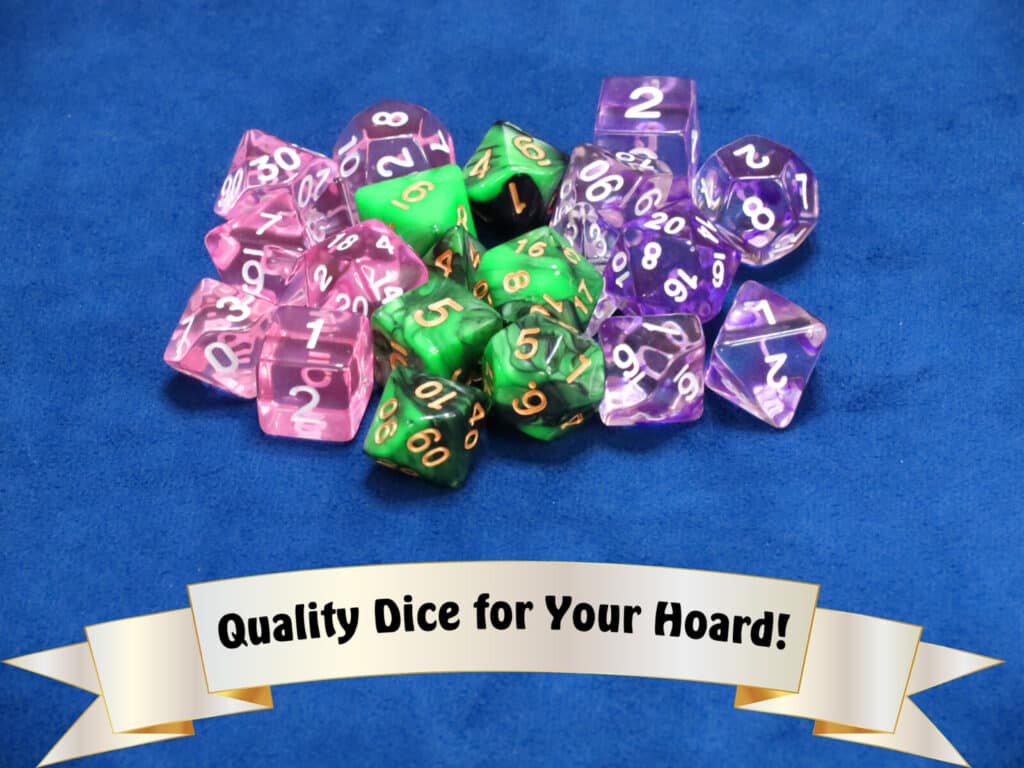

Proud to embrace the locally created moniker of “Corrupt Overlord” from one of the all time great Lords of Waterdeep runs, Shane is one member of the Assorted Meeples crew and will be hard at work creating awesome content for the website. He is a long-time player of board games, one time semi-professional poker player, and tends to run to the quirky or RPG side of things when it comes to playing video games. He loves tabletop roleplaying systems like Dungeons & Dragons, Pathfinder, Werewolf, Fate, and others, and not only has been a player but has run games as DM for years. You can find his other work in publications like Level Skip or Hobby Lark.
